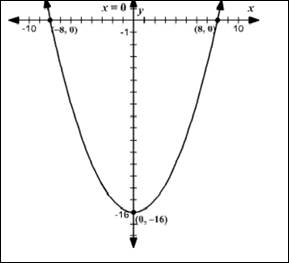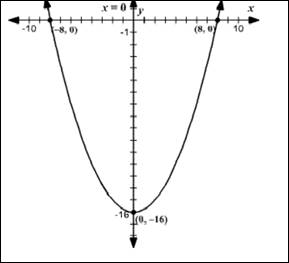
(a).
To graph: Quadratic function with its vertex, axis of symmetry,
(a).
Answer to Problem 17RE
Function using the vertex and the

Explanation of Solution
Given:
Calculation:
The quadratic function
So,
Here,
So the graph opens up.
To find the vertex,
The coordinates of the vertex of a quadratic function of the form
Evaluating
Evaluating
Thus, the vertex is at
The axis of symmetry is the line where
Thus,
To find
Here,
Therefore, the graph has the
Find the discriminant
In case discriminant
Therefore, the graph of the function crosses the
To find out the
The
Multiplying each side of the equation by
Add
Make use of square root method to solve the equation. According to the square root method, if
Function using the vertex and the

Conclusion:
Quadratic function with its vertex is
(b).
Domain and range of the function.
(b).
Answer to Problem 17RE
Domain is the interval
Explanation of Solution
Given:
Calculation:
Find the domain and range of the function, the domain of
From the graph, find the domain is the interval
Conclusion:
Thus, domain is the interval
(c).
Determine the function is increasing and where it is decreasing.
(c).
Answer to Problem 17RE
The function
Explanation of Solution
Given:
Calculation:
Interval where the function
Also,, find where the function is increasing.
From the graph, the function
Conclusion:
Thus, the function
Chapter 3 Solutions
Precalculus
Additional Math Textbook Solutions
Elementary Statistics
Pre-Algebra Student Edition
Calculus: Early Transcendentals (2nd Edition)
Algebra and Trigonometry (6th Edition)
Elementary Statistics (13th Edition)
- Let the region R be the area enclosed by the function f(x)= = 3x² and g(x) = 4x. If the region R is the base of a solid such that each cross section perpendicular to the x-axis is an isosceles right triangle with a leg in the region R, find the volume of the solid. You may use a calculator and round to the nearest thousandth. y 11 10 9 00 8 7 9 5 4 3 2 1 -1 -1 x 1 2arrow_forwardLet the region R be the area enclosed by the function f(x) = ex — 1, the horizontal line y = -4 and the vertical lines x = 0 and x = 3. Find the volume of the solid generated when the region R is revolved about the line y = -4. You may use a calculator and round to the nearest thousandth. 20 15 10 5 y I I I | I + -1.5 -1 -0.5 0.5 1 1.5 2 2.5 3 -5 I -10 -15 I + I I T I I + -20 I + -25 I I I -30 I 3.5 4 xarrow_forwardplease show all the workarrow_forward
 Calculus: Early TranscendentalsCalculusISBN:9781285741550Author:James StewartPublisher:Cengage Learning
Calculus: Early TranscendentalsCalculusISBN:9781285741550Author:James StewartPublisher:Cengage Learning Thomas' Calculus (14th Edition)CalculusISBN:9780134438986Author:Joel R. Hass, Christopher E. Heil, Maurice D. WeirPublisher:PEARSON
Thomas' Calculus (14th Edition)CalculusISBN:9780134438986Author:Joel R. Hass, Christopher E. Heil, Maurice D. WeirPublisher:PEARSON Calculus: Early Transcendentals (3rd Edition)CalculusISBN:9780134763644Author:William L. Briggs, Lyle Cochran, Bernard Gillett, Eric SchulzPublisher:PEARSON
Calculus: Early Transcendentals (3rd Edition)CalculusISBN:9780134763644Author:William L. Briggs, Lyle Cochran, Bernard Gillett, Eric SchulzPublisher:PEARSON Calculus: Early TranscendentalsCalculusISBN:9781319050740Author:Jon Rogawski, Colin Adams, Robert FranzosaPublisher:W. H. Freeman
Calculus: Early TranscendentalsCalculusISBN:9781319050740Author:Jon Rogawski, Colin Adams, Robert FranzosaPublisher:W. H. Freeman
 Calculus: Early Transcendental FunctionsCalculusISBN:9781337552516Author:Ron Larson, Bruce H. EdwardsPublisher:Cengage Learning
Calculus: Early Transcendental FunctionsCalculusISBN:9781337552516Author:Ron Larson, Bruce H. EdwardsPublisher:Cengage Learning





